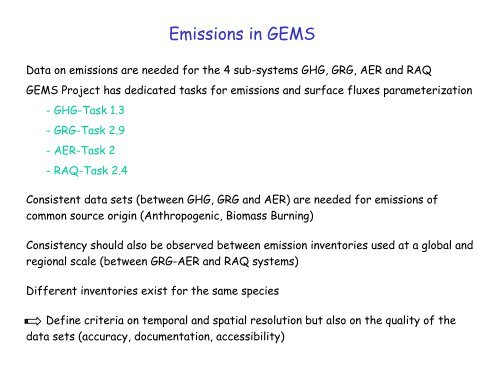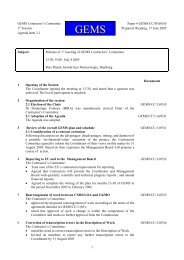sea salt: Gong et al. (1997) - GEMS
sea salt: Gong et al. (1997) - GEMS
sea salt: Gong et al. (1997) - GEMS
You also want an ePaper? Increase the reach of your titles
YUMPU automatically turns print PDFs into web optimized ePapers that Google loves.
Emissions in <strong>GEMS</strong><br />
Data on emissions are needed for the 4 sub-systems GHG, GRG, AER and RAQ<br />
<strong>GEMS</strong> Project has dedicated tasks for emissions and surface fluxes param<strong>et</strong>erization<br />
- GHG-Task 1.3<br />
- GRG-Task 2.9<br />
- AER-Task 2<br />
- RAQ-Task 2.4<br />
Consistent data s<strong>et</strong>s (b<strong>et</strong>ween GHG, GRG and AER) are needed for emissions of<br />
common source origin (Anthropogenic, Biomass Burning)<br />
Consistency should <strong>al</strong>so be observed b<strong>et</strong>ween emission inventories used at a glob<strong>al</strong> and<br />
region<strong>al</strong> sc<strong>al</strong>e (b<strong>et</strong>ween GRG-AER and RAQ systems)<br />
Different inventories exist for the same species<br />
Define criteria on tempor<strong>al</strong> and spati<strong>al</strong> resolution but <strong>al</strong>so on the qu<strong>al</strong>ity of the<br />
data s<strong>et</strong>s (accuracy, documentation, accessibility)
Current CO 2<br />
surface fluxes in <strong>GEMS</strong><br />
• Anthropogenic emissions : Fossil Fuel burning, Cement Production and Gas Flaring<br />
Estimates for 1995 (tot<strong>al</strong> 6.17 PgC/year), data base developed by the CDIAC<br />
Based on nation<strong>al</strong> statistics databases, density of population used to distribute the emissions<br />
ref. (Brenkert, 1998 ; Andres <strong>et</strong> <strong>al</strong>., 1996)<br />
• Air-Sea CO2 exchange : Fluxes are based on Takahashi <strong>et</strong> <strong>al</strong>. (2002) climatology<br />
Estimates are based on measurements of pCO2 in surface waters b<strong>et</strong>ween 1960 and 1995<br />
The annu<strong>al</strong> oceanic uptake estimate is about -2.2 PgC/year<br />
• Exchange with terrestri<strong>al</strong> ecosystem : NEP Estimates are taken from Randerson <strong>et</strong> <strong>al</strong>. <strong>1997</strong><br />
using CASA (links remote sensing data, m<strong>et</strong>eorologic<strong>al</strong> data and surface observations)<br />
The N<strong>et</strong> Ecosystem Production NEP = GPP - AR – HR<br />
Photosynthesis<br />
Annu<strong>al</strong>ly b<strong>al</strong>anced terrestri<strong>al</strong> biosphere<br />
NPP<br />
Plant respiration<br />
Soil components<br />
respiration<br />
Biomass burning disturbances are not taken into account (4PgC/year = 7% of annu<strong>al</strong> NPP)<br />
Note : Oxidation of reduced carbon species are taken into account implicitly in some of these<br />
estimations ; they are released at the surface rather than distributed in the atmosphere
Aerosol sources<br />
• For the introduction of aerosol processes in the ECMWF IFS, the initi<strong>al</strong><br />
emission fluxes and sources are taken from:<br />
– <strong>sea</strong> <strong>s<strong>al</strong>t</strong>: <strong>Gong</strong> <strong>et</strong> <strong>al</strong>. (<strong>1997</strong>)<br />
– desert dust: INCA, Schulz <strong>et</strong> <strong>al</strong>. (1998), Guelle <strong>et</strong> <strong>al</strong>. (2000)<br />
– And other constituents from AEROCOM intercomparison data s<strong>et</strong>s<br />
Organic matter: Bond and Stre<strong>et</strong>s (1996)<br />
Black carbon: Bond and Stre<strong>et</strong>s (1996), GFED<br />
Sulfate: IIASA, dGEIA, Guenter <strong>et</strong> <strong>al</strong>. (1994)<br />
• Within <strong>GEMS</strong>-Aerosols, refinement of aerosol emission sources is de<strong>al</strong>t with in<br />
WP_AER2<br />
> update and assimilation of the anthropogenic emission inventories of aerosol and<br />
its precursors<br />
> assimilation of information on wild fires<br />
> quantification of the wind-blown dust emission from desert areas<br />
> quantification of the wind-blown <strong>sea</strong> <strong>s<strong>al</strong>t</strong> emission<br />
> sources of stratospheric aerosols
Emissions for GRG<br />
Many species (VOC)<br />
Different inventories exist at region<strong>al</strong> or glob<strong>al</strong> sc<strong>al</strong>e based on<br />
different m<strong>et</strong>hodologies or statistic<strong>al</strong> data<br />
Inventories may overlap in space and time and may include similar data<br />
s<strong>et</strong>s<br />
A compiled list of glob<strong>al</strong> and region<strong>al</strong> inventories is needed with a<br />
d<strong>et</strong>ailed content, reference years, space and time resolution<br />
starting base : - HALO paper on emissions (J. Flemming)<br />
- Finnish M<strong>et</strong>eorologic<strong>al</strong> Institute initiative<br />
VOC break down ?<br />
Discussion is needed for the datas<strong>et</strong>s to be implemented
Emission inventory for Region<strong>al</strong> Air Qu<strong>al</strong>ity<br />
across Europe<br />
Decide on a common emissions inventory for anthropogenic<br />
emissions, gases and particulate matter<br />
EMEP/CORINAIR inventory will be the basis for yearly tot<strong>al</strong>s and<br />
their historic<strong>al</strong> evolution<br />
- Downsc<strong>al</strong>ing for a resolution of ~ 5 km<br />
-Tempor<strong>al</strong> profiles on the diurn<strong>al</strong>, weekly and <strong>sea</strong>son<strong>al</strong> timesc<strong>al</strong>es
How important are emissions from Biomass Burning?<br />
Only in the two past decades have re<strong>sea</strong>rchers re<strong>al</strong>ized the important<br />
contributions of biomass burning to the glob<strong>al</strong> budg<strong>et</strong>s of many radiatively<br />
and chemic<strong>al</strong>ly active gases, and element<strong>al</strong> carbon particulates<br />
Fossil fuel<br />
6.2 Pg C/yr<br />
Biomass burning 4 Pg C/yr (Andreae and Merl<strong>et</strong> 2001)<br />
N<strong>et</strong> effect uncertain<br />
Estimates vary but biomass burning contributes up to:<br />
10 % of CH 4<br />
38% of tropospheric O 3<br />
42% of BC (Bond <strong>et</strong> <strong>al</strong>., 2004)<br />
74% of OC
Biomass Burning emissions in <strong>GEMS</strong><br />
Biomass burning is a major source for greenhouse gases, reactive<br />
gases and aerosols<br />
Biomass burning can be observed from space<br />
Emissions from biomass burning are subject to high uncertainties,<br />
some investment is required to improve the qu<strong>al</strong>ity of estimations<br />
Time resolution required for GRG and AER sub-projects have to<br />
be considered for the choice of data s<strong>et</strong>s<br />
It is <strong>al</strong>so important to prepare emission data supply for the<br />
operation<strong>al</strong> phase of the assimilation system
Emissions in <strong>GEMS</strong> - Outline<br />
Consistency in emission data s<strong>et</strong>s should be achieved b<strong>et</strong>ween<br />
the 4 sub-systems within <strong>GEMS</strong><br />
A compiled list of emission inventories (present species, time<br />
and space coverage, resolution, qu<strong>al</strong>ity) as a base for decisions<br />
Biomass burning emissions in <strong>GEMS</strong> ?<br />
Tempor<strong>al</strong> resolution for GRG and AER<br />
What else?



